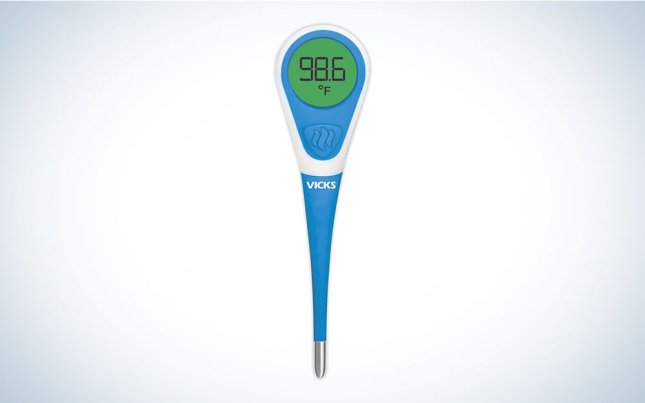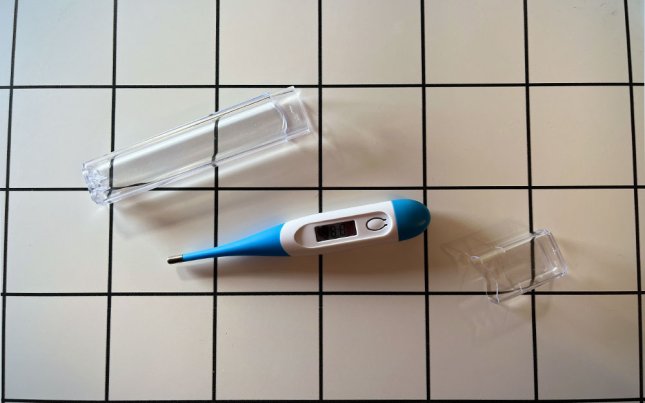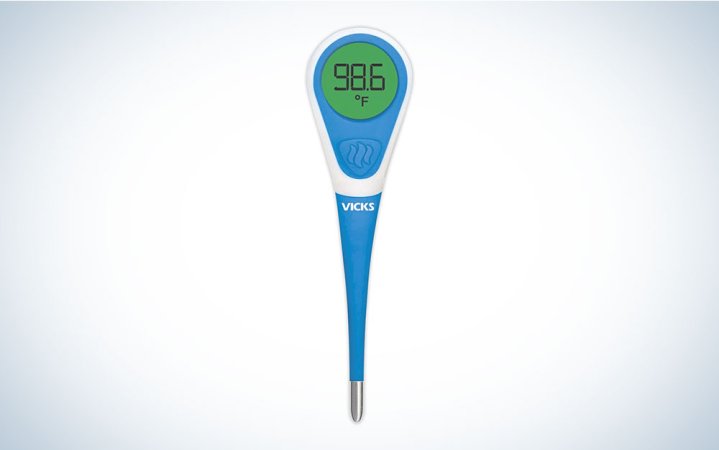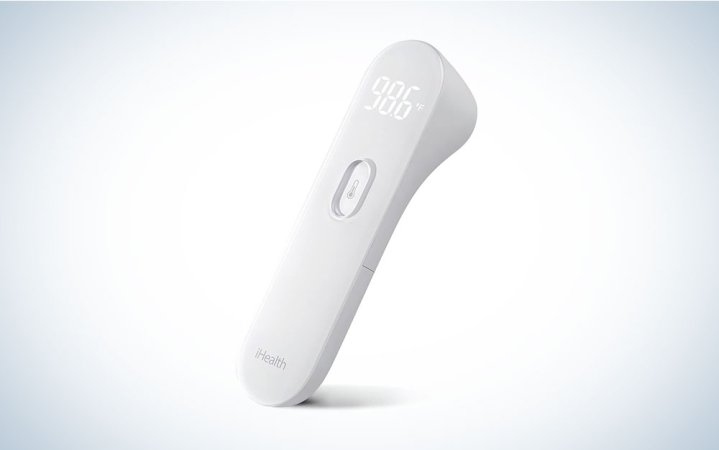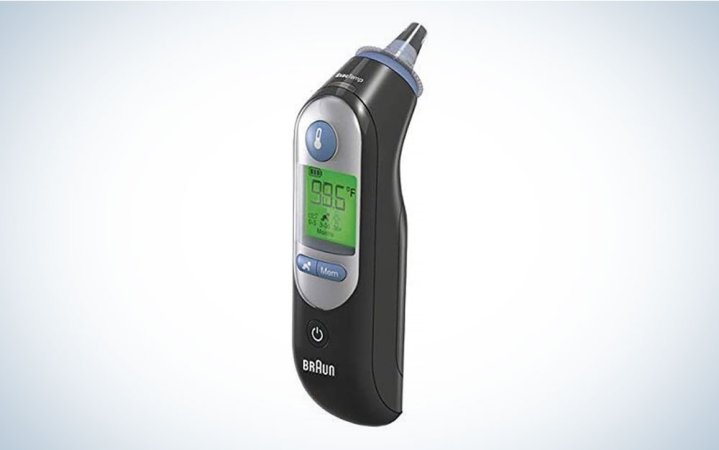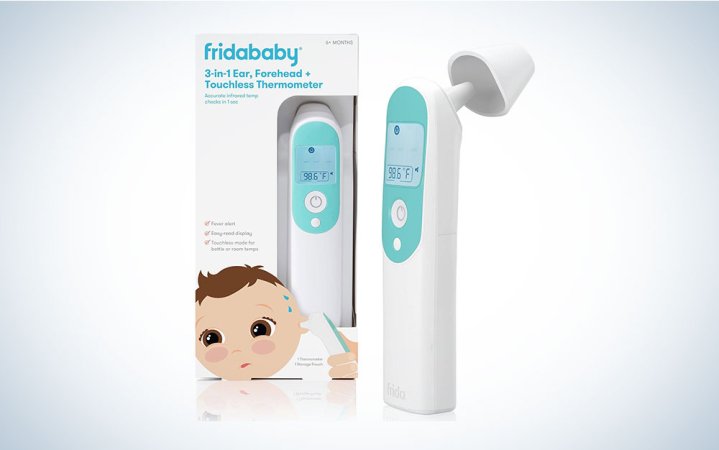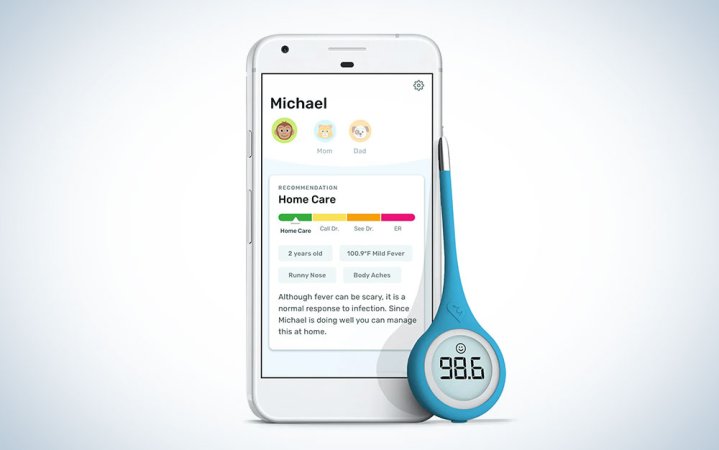We may earn revenue from the products available on this page and participate in affiliate programs. Learn more ›
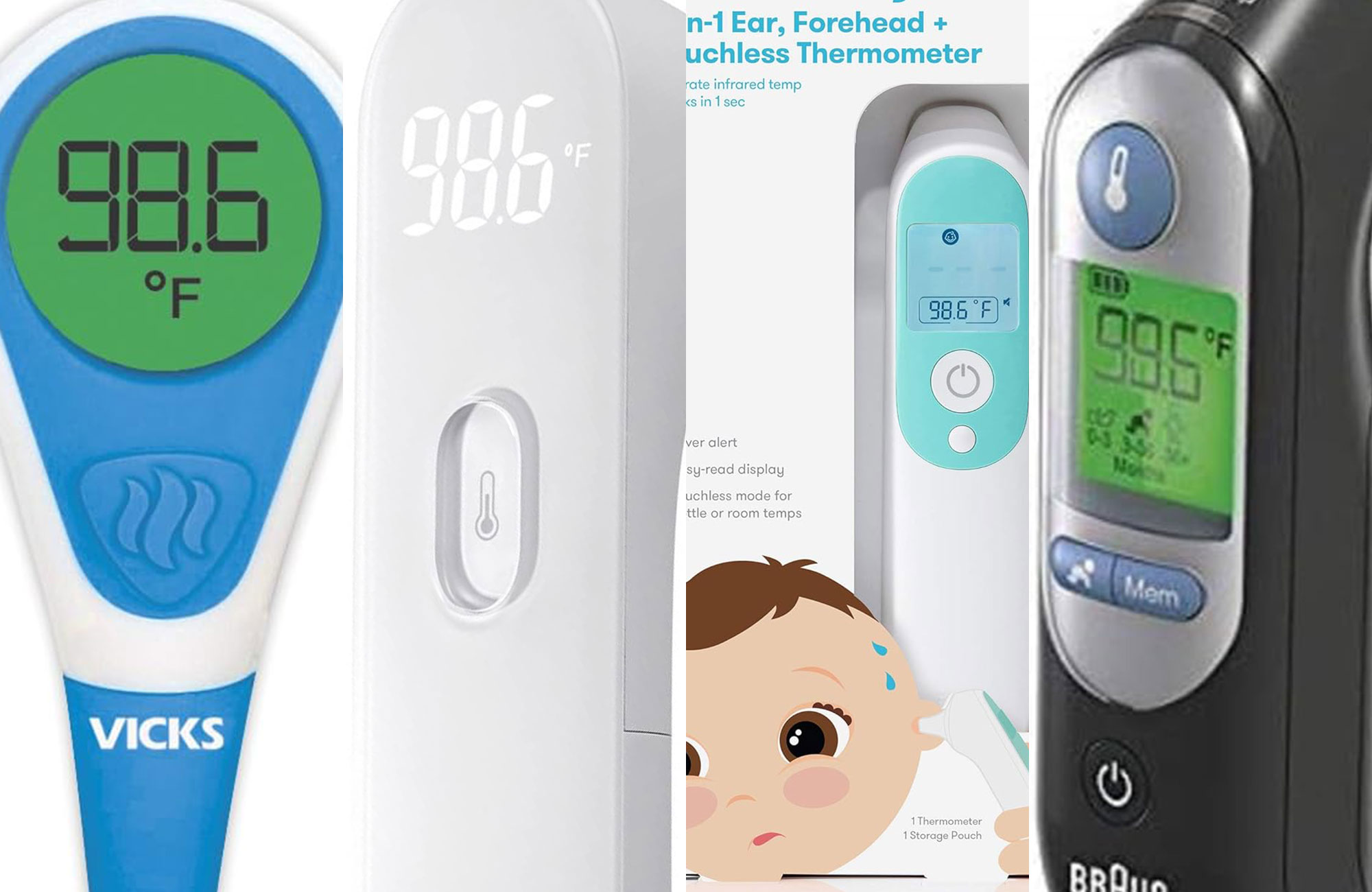
When you have the sniffles, a thermometer can determine if you have a fever or not. If you’re thinking, “I can just wait for this alien hot-cold feeling to pass,” you might want to reconsider your stance. Having a fever can be fatal. If your fever is higher than 105°F, get thee to an emergency room. Anything higher than that could lead to brain damage, seizures, and shock—all those are way more bothersome than a sore throat and runny nose. You should schedule a telehealth appointment or quick visit to your healthcare provider otherwise. From COVID-19 to flu season to a regular cold, tracking your temperature can determine if you’re getting better. Your body turns itself into a furnace to smoke out the virus and activate your immune response; if your body temperature returns to normal, it most likely means the meds you’re taking are working. Monitoring your temperature can indicate the beginnings of sickness even if you feel fine. The best thermometers can help you start preventative measures to beat your cold faster or track your temperature for peace of mind.
- Best overall: Vicks ComfortFlex Digital Thermometer
- Best infrared: iHealth No-Touch Forehead Thermometer Infrared Digital Thermometer
- Best ear: Braun ThermoScan 7–Digital Ear Thermometer
- Best for kids: Frida Baby Infrared Thermometer
- Best smart: Kinsa QuickCare Smart Digital Thermometer
- Best budget: Boncare Digital Oral Thermometer
How we chose the best thermometers
Going to the nurse’s office in elementary school was a treat. You got to lay on the cold vinyl lounges that smelled and felt like diner benches and get some peace and quiet. Did I love the taste of the thermometer cover? No, nor did I enjoy getting the underside of my tongue prodded. My temperature was rarely ever high enough to get sent home, but I could have used a thermometer there (and maybe Ferris Bueller’s acting skills) to get some extra sick days in. To pick our favorite thermometers, we looked at critical reviews and user recommendations and conducted testing so any child reading this can get the chances I didn’t to stay home from school.
The best thermometers: Reviews & Recommendations
Being sick sucks. Getting a reading on how sick you are—or how sick you’re going to be—can give you a chance to order some electrolytes and ruminate on what your illness binge-watch will be. (We’re fans of Love Island, the OG Brit version only).
Best overall: Vicks ComfortFlex Digital Thermometer
Pros
- Easy to read
- Accurate
- Versatile
Cons
- Cover hard to remove to replace batteries
Specs
- Weight: 1.76 ounces
- Dimensions: 4.5 x .5 inches
- Power source: Battery-powered
- Reading area: Mouth, rectum, underarm
This Vicks thermometer gives accurate readings in less than 10 seconds to get results quickly. Its memory feature recalls and displays the last temperature taken, and its screen color signifies temperature. You’ll get a green display for a normal temperature, yellow for elevated temperature, and red for high temperature. A flexible tip makes it perfect for all ages, and you can take oral, rectal, and underarm readings. It’s waterproof, easy to clean, and it’s BPA-free. This gentle and fast thermometer is perfect if you’re looking for a well-designed thermometer that’s spot-on.
Best infrared: iHealth No-Touch Forehead Thermometer Infrared Digital Thermometer
Pros
- Perfect for maintaining distance to take temperatures
- Fast
- Intuitive
Cons
- Not as accurate as other choices
Specs
- Weight: 4.59 ounces
- Dimensions: 5.39 x 1.54 inches
- Power source: Battery-powered
- Reading area: Forehead
If getting up close with someone who could carry a communicable illness makes you shiver, get a temperature from a safer distance—and without having to unmask—with an infrared thermometer. Simply hold the thermometer around an inch from the forehead, hold the button, and wait just one second to get the temp. The thermometer sensor collects more than 100 data points per second, while environmental sensors work to keep outside factors from affecting the reading. It’s not as accurate as other thermometers, but it’s perfect to get everyone’s temperature before an inside gathering. An easy-to-read, extra-large LED display works in darkness, and the device vibrates when it’s done. No more beeps. You can use it on babies and the elderly, making it a do-all forehead thermometer.
Best ear: Braun ThermoScan 7–Digital Ear Thermometer
Pros
- Disposable lens filter included
- Age precision technology
- Beep and light confirms proper positioning
Cons
- Expensive
Specs
- Weight: 10.4 ounces
- Dimensions: 5.7 x 2.1 inches
- Power source: Battery-powered
- Reading area: Ear
If you’re looking for an ear thermometer, the Braun ThermoScan has features that make it a great choice for the entire family. Age-adjustable fever guidance helps you decide if you should make a trip to UrgentCare or not, and a color-coded display makes interpreting results easy. It comes with a pre-warmed tip that helps with accuracy (cooler tips result in lower temperatures), and disposable lens filters make things hygienic. A light and a beep confirm proper positioning so it’s used correctly. It’s a splurge, but we think it’s well worth it.
Best for kids: Frida Baby Infrared Thermometer
Pros
- 3-in-1
- Large memory
- Sound and color alerts
Cons
- Results not as accurate
Specs
- Weight: 4 ounces
- Dimensions: 3 x 1 inches
- Power source: Batteries
- Reading area: Forehead, ear
Kids are hard to wrangle and a little cranky when they get sick. Make it easier for the whole family with the Frida Baby infrared thermometer. It can take temperatures from the forehead, room or bottle, and ear. Color-coded fever alerts allow you to quickly assess results, which come in 1 second. You can also choose if you want sound alerts as well. Its memory stores 40 previous temperatures, and a storage pouch keeps your thermometer protected from dust and debris. It’s not as accurate as other kinds of thermometers, but it is a great option to quickly and painlessly take a child’s temperature.
Best smart: Kinsa QuickCare Smart Digital Thermometer
Pros
- Accurate
- Reliable
- Fast
Cons
- Doesn’t adjust temperature with age
Specs
- Weight: 2.4 ounces
- Dimensions: 5.7 inches
- Power source: Battery
- Reading area: Mouth, underarm, rectum
Synced to your phone via Bluetooth, this thermometer enables all kinds of data tracking and sharing. Someone in the home can take a reading, and another guardian can get a notification of the reading results. The app syncs up fast, and you can keep multiple profiles to temp track the entire family. The app also lets you make a timeline of fever readings, med administering, and naps. This makes it easy to relay a child’s symptoms to a healthcare provider. You can use it orally, rectally, or via the underarm, and it only takes less than eight seconds to get a reading back. A large lighted display makes it easy to read temperatures, and a bendable tip makes it comfortable to get a temperature. The app turns your thermometer into your own nurse at home but doesn’t adjust for temperature differences between ages. Some reviews note having problems syncing the thermometer with the app.
Best budget: Boncare Digital Oral Thermometer
Pros
- Cheap
- Fast
Cons
- You get what you pay for
- Hard to see temperature on small display
Specs
- Weight: .37 ounces
- Dimensions: 4.93 x .76 inches
- Power source: Battery operated
- Reading area: Mouth, underarm, rectum
The value thermometer has multiple features found on higher-priced thermometers. It recalls your last reading, and it beeps when reading is complete. It takes about 10 seconds to read temperatures, and you can use it in your mouth, rectum, or underarm. The LCD display is a little small and can be hard to read, but there’s nothing a little head tilt can’t fix. It switches in between Celcius and Fahrenheit, and it’s easy to clean. You get a durable, hard plastic case to store it when not in use. It’s small enough to stow away in a first-aid kit, and cheap enough that you can buy more than one without breaking the bank.
What to consider when buying the best thermometers
As we’ve been taught by our parents, teachers, and guardians, it’s unwise to go around sticking just about anything in your mouth. Thermometers are the rare exception. Here’s what you should know before putting one into any of the orifices in your body.
Type of thermometer
There are three kinds of thermometers: contact thermometers, where electronic sensors record body temperature; remote thermometers, which don’t require skin contact for a reading; and mercury thermometers, where the toxic element is encased in glass. Mercury thermometers aren’t typically used because they can break and cause a hazard.
Your thermometer should have a way to read it and a way to take the temperature. You can also find bonus features like a large display for easy reading, a beeping alert when the thermometer is done reading the temperature, or an on/off button.
Reading location
You can take temperatures from many areas of the body. We’ve outlined some of the most popular locations:
- Rectal: Taking temperatures with a rectal thermometer will give you the most accurate result, which is important for infants. However, it can be uncomfortable to take someone’s temperature rectally. You also want to ensure the rectal thermometer is kept far away from the oral thermometers in your home—you wouldn’t want to get them mixed up.
- Oral: Oral temperature readings are generally pretty accurate but not as accurate as rectal thermometers. You need to take 15 minutes after eating or drinking to take an oral temperature—your hot, healing soup could affect the reading. For those suffering from a stuffy nose, keeping your mouth closed long enough to get an accurate reading can be a challenge.
- Armpit: Taking a reading from an armpit is great if you can’t take temperatures orally. They’re not the most accurate. You can use the same kind of thermometer for rectal and oral readings for armpit readings, but we recommend keeping an armpit thermometer an armpit thermometer. If you’ve just taken a shower or bath, or if you’ve been in/under multiple layers, wait 20-30 minutes before taking the reading. You have to take your shirt off and tuck the thermometer under your armpit to get a reading.
- Temporal artery: Forehead thermometers use an infrared scanner to measure temperature. It works quickly and is painless to do. However, it’s expensive and less accurate than a contact thermometer. User error, direct sunlight, sweat, and cold weather can affect readings.
- Ear: Tympanic thermometers use an infrared beam to take the temperature from your ear canal. Tympanic thermometers are quick and comfortable to use. They aren’t recommended for newborns. Earwax and the shape of your ear canal can affect the accuracy of the reading.
FAQs
You can use rubbing alcohol or use lukewarm, soapy water to clean a thermometer. Rinse, and then wipe it dry or let it air dry. You can also opt for disposable probe covers.
You can, just like how you can eat those little fruit puffs marketed to babies. However, some are designed just for babies and are smaller. Use as instructed, so your temperature reading is accurate.
No. Mercury is toxic, and could be dangerous if not cleaned up properly. You can fully wreck the environment if this happens. There’s also a chance of the glass breaking. If you do break a mercury thermometer, open the windows, close the doors to other rooms, put on rubber, latex, or nitrile gloves, and use an eyedropper to clean up the mercury beads. Put that eyedropper into a sandwich bag with a zip closure. Then, when all of the mercury is cleaned up, contact your local health and fire department to dispose of it properly.
Final thoughts on the best thermometers
- Best overall: Vicks ComfortFlex Digital Thermometer
- Best infrared: iHealth No-Touch Forehead Thermometer Infrared Digital Thermometer
- Best ear: Braun ThermoScan 7–Digital Ear Thermometer
- Best for kids: Frida Baby Infrared Thermometer
- Best smart: Kinsa QuickCare Smart Digital Thermometer
- Best budget: Boncare Digital Oral Thermometer
A thermometer can accurately read your body temperature to see where you’re in your #healing journey. Pushing yourself while sick isn’t good for you or the people around you: We’ve learned by now that you should not go to work sick (and you should mask up if you do) or risk turning the office party into a superspreader event. We welcome you to languish, lounge, and watch all the trashy television you’d like; just take your temperature occasionally to ensure you’re on the road to recovery.
